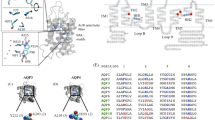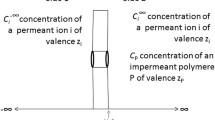Summary
The relation of osmotic to diffusional water permeability of human red blood cells was compared after treating the cells with different concentrations of PCMBS (p-chloromercuribenzene sulfonate). After subtracting the PCMBS-insensitive permeability (presumably the water permeability of the lipid bilayer) from each, the ratio of osmotic to diffusional permeability remains invariant (≈11) as more and more water channels are inhibited by increasing concentrations of PCMBS. This result implies that the channels close in an all-or-none way and suggests a two-state model. Analysis of the dependence of osmotic water permeability on PCMBS concentration in terms of the model reveals a 1∶1 stoichiometry and a dissociation constant for the PCMBS/membrane receptor complex of about 0.019mm at 37°C. Temperature dependence studies show that the reaction is entropically driven (ΔH o≈25 kcal/mol, ΔS o≈100 cal/moldeg) and suggest the involvement of hydrophobic interactions.
Similar content being viewed by others
References
Banerjee, K., Lauffer, M.A. 1966. Polymerization-depolymerization of tobacco mosaic virus protein. VI. Osmotic pressure studies of early stages of polymerization.Biochemistry 5:1957–1964
Benesch, R., Benesch, R.E. 1962. Determination of SH groups in proteins.In: Methods of Biochemical Analysis. D. Glick, editor. Vol. 10, pp. 43–70. Wiley Interscience, New York
Brahm, J. 1982. Diffusional water permeability of human erythrocytes and their ghosts.J. Gen. Physiol. 79:791–819
Brahm, J., Wieth, J.O. 1977. Separative pathways for urea and water, and for chloride in chicken erythrocytes.J. Physiol. (London) 266:727–749
Brown, F. 1983. The effect of compartmental location on the protonT *2 of small molecules in cell suspension: A cellular field gradient model.J. Magn. Reson 54:385–399
Cass, A., Finkelstein, A. 1967. Water permeability of thin lipid membranes.J. Gen. Physiol. 50:1765–1784
Conlon, T., Outhred, R. 1972. Water diffusion permeability of erythrocytes using an NMR technique.Biochim. Biophys. Acta 288:354–361
Conlon, T., Outhred, R. 1978. The temperature dependence of erythrocyte water diffusion permeability.Biochim. Biophys. Acta 511:408–511
Dick, D.A.T. 1965. Cell Water. Butterworths, Washington
Edelhoch, H., Osborne, J.C., Jr. 1976. The thermodynamic basis of the stability of proteins, nucleic acids, and membranes.In: Advances in Protein Chemistry. C.B. Anfinsen, J.T. Edsall and F.M. Richards, editors. Vol. 30, pp. 183–250. Academic, New York
Everitt, C.T., Redwood, W.R., Haydon, D.A. 1969. Problem of boundary layers in the exchange diffusion of water across bimolecular lipid membranes.J. Theor. Biol. 22:20–32
Farmer, R.E.L., Macey, R.I. 1970. Perturbation of red cell volume: Rectification of osmotic flow.Biochim. Biophys. Acta 196:53–65
Finkelstein, A., Rosenberg, P.A. 1979. Single-file transport: Implications for ion and water movement through gramicidin A channels.In: Membrane Transport Processes. C.F. Stevens and R.W. Tsien, editors. Vol. 3, pp. 73–88. Raven, New York
Hanai, T., Haydon, D.A., Redwood, W.R. 1966. The water permeability of artificial bimolecular leaflets: A comparison of ratio-tracer and osmotic methods.Ann. N.Y. Acad. Sci. 137:731–739
Haydon, D.A. 1969. Some recent developments in the study of bimolecular lipid films.In: Molecular Basis of Membrane Transport. D.C. Tosteson, editor. pp. 111–132. Prentice Hall, Englewood Cliffs
Inoue, S., Sato, H. 1967. Cell motility by labile association of molecules. The nature of mitotic spindle fibers and their role in chromosome movement.J. Gen. Physiol. (Suppl.)5:259–292
Kauzmann, W. 1959. Some factors in the interpretation of protein denaturation.Adv. Protein Chem. 14:1–63
Lea, E.J.A. 1963. Permeation through long narrow pores.J. Theor. Biol. 5:102–107
Levitt, D.G. 1974. A new theory of transport for cell membrane pores. I. General theory and application to red cell.Biochim. Biophys. Acta 373:115–131
Macey, R.I. 1979. Permeability of red cells to water and nonelectrolytes.In: Transport Across Biological Membranes. G. Giebisch, D.C. Tosteson and H.H. Ussing, editors. Vol. II, pp. 1–57. Springer-Verlag, Amsterdam
Macey, R.I., Chien, D., Moura, T., Karan, D. 1979. Closure of water channels in the red cell.Biophys. J. 25:102 (abstract)
Macey, R.I., Farmer, R.E.L. 1970. Inhibition of water and solute permeability in human red blood cell.Biochim. Biophys. Acta 211:104–106
Macey, R.I., Karan, D.M., Farmer, R.E.L. 1972. Properties of water channels in human red cells.In: Biomembranes. F. Kreuzer and J.F.G. Slegers, editors. Vol. 3, pp. 331–340. Plenum, New York
Mlekoday, H.J., Moore, R., Levitt, D.G. 1983. Osmotic water permeability of the human red cell.J. Gen. Physiol. 81:213–220
Naccache, P., Sha'afi, R.I. 1974. Effect of PCMBS on water transfer across biological membranes.J. Cell. Physiol. 83:449–456
Paganelli, C.V., Solomon, A.K. 1957. The rate of exchange of tritiated water across the human red blood cell membrane.J. Gen. Physiol. 41:259–277
Patai, S. 1974. The chemistry of the thiol group. Parts I and II. John Wiley and Sons, New York
Solomon, A.K., Chasan, B., Lukacovic, M.F., Dix, J.A., Verkman, A.S. 1981. Possible relation between anion transport and water flow in red cells.Fed. Proc. 40:484 (abstract)
Vieira, F.L., Sha'afi, R.I., Solomon, A.K. 1970. The state of water in human and dog red cell membranes.J. Gen. Physiol. 55:451–466
Webb, J.L. 1966. Enzyme and Metabolic Inhibitor II. p. 749. Academic, New York and London
Author information
Authors and Affiliations
Rights and permissions
About this article
Cite this article
Moura, T.F., Macey, R.I., Chien, D.Y. et al. Thermodynamics of all-or-none water channel closure in red cells. J. Membrain Biol. 81, 105–111 (1984). https://doi.org/10.1007/BF01868975
Received:
Issue Date:
DOI: https://doi.org/10.1007/BF01868975




